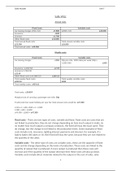Sadia Hussain Unit 7
Sally Wizz
Annual costs
Fixed Costs Variable costs
Car leasing charges (150 x 52) £7,800 (£500 x 52) £26,000
Insurance £400
Licenses £1,700
Other fixed costs £14,000
Total annual fixed costs Total annual variable costs
£23,900 £26,000
Total annual costs: £49,900
Weekly costs
Fixed Costs Variable costs
Car leasing charges £150 50p per mile, 1000 miles per week (50p x
1,000/100) £500
Insurance (£400/52) £7.69
License (£1,700/52)
£32.69
Other fixed costs (£14,000/52) £269.23
Total weekly fixed costs: Total weekly variable costs:
£459.61 £500
Total weekly costs: £959.61
Total costs: £50,859
Marginal cost of carrying a passenger one mile: 50p
If sally took four week holiday per year her total annual costs would be: £47,300
£150 x 4 = 600, £500 x 4 = 2,000
2,000 + 600 = £2600
£49,900 - £2600 = £47,300
Fixed costs - There are two types of costs, variable and fixed. Fixed costs are costs that are
not linked to production; they do not change depending on how much output is made. So
no matter how much output a company produces, the fixed will stay the exact same. They
do change, but the change is not linked to the production levels. Some examples of fixed
costs include rent, insurance, lighting interest payments and internet. For example, if a
bakery bakes 100 cakes or 10, their fixed will stay the same, because they are not related to
the quantity of the cakes.
Variable costs - The other type of costs are variable costs, these are the opposite of fixed
costs and do change depending on the levels of production. These costs are linked to the
quantity of output that is produced, if more output is produced then these costs will
increase and if the quantity of the output decrease then these costs will also go down.
Variable costs include direct materials related to the output or the cost of sales, sales
1





